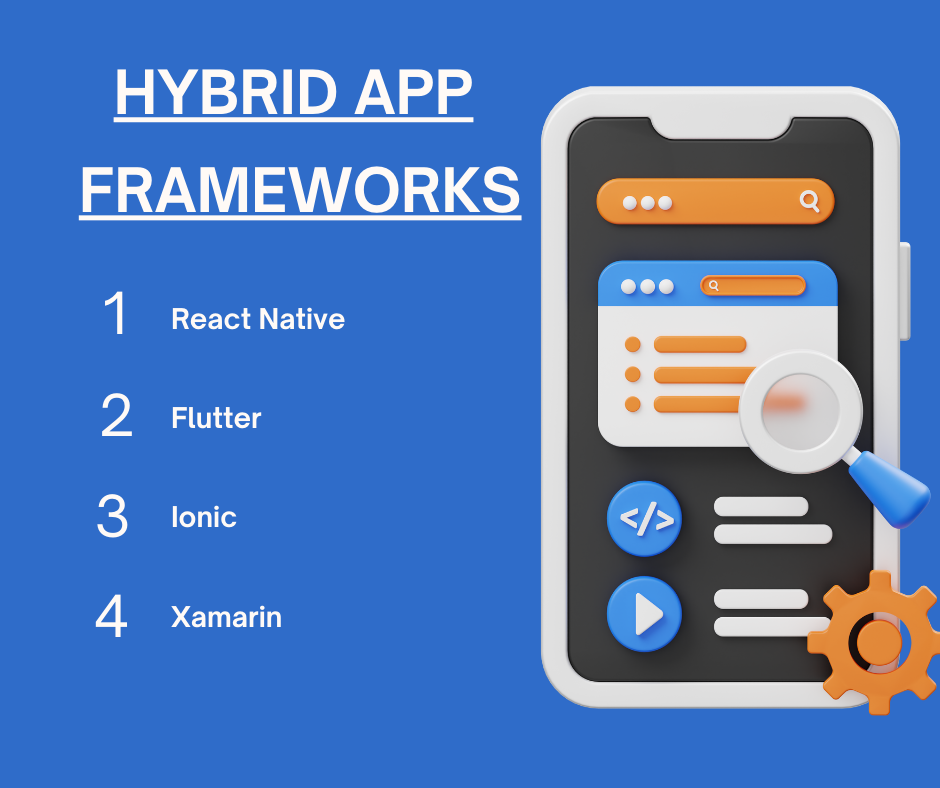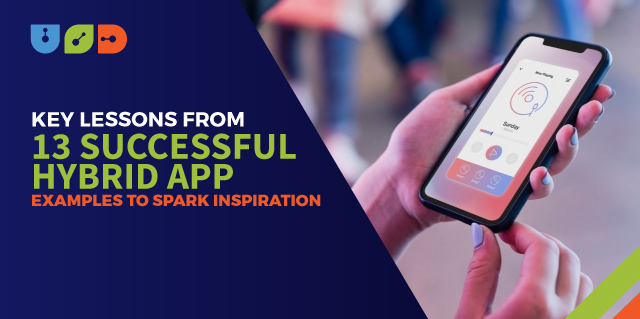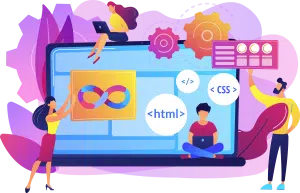Table of Contents
ToggleMobile apps have become an essential component of our daily life for incorporating diverse requirements and preferences. When it comes to developing mobile apps, businesses have two primary choices: native apps and hybrid apps. Hybrid apps, in particular, have gained popularity due to their ability to combine both – native and web technologies. This article will explore key lessons from thirteen successful hybrid app examples to inspire and guide your app development journey.
What are Hybrid Apps?
Hybrid apps are mobile applications that are developed using web technologies such as HTML, CSS, and JavaScript and then wrapped in a native app shell. This allows hybrid apps to be installed and run on multiple platforms, including iOS and Android, using a single codebase. Hybrid apps leverage web technologies and frameworks to deliver a consistent user experience across different devices, making them a cost-effective and efficient choice for app development.
Importance of Hybrid Apps
Hybrid apps have gained significant importance in mobile app development services. They offer a range of benefits that make them an attractive choice for businesses. Hybrid apps allow for faster development and deployment, reduced costs, and wider reach across multiple platforms. They also provide access to device features and can be easily updated and maintained. These advantages make hybrid apps a valuable tool for businesses looking to expand their digital presence and engage with a broader audience.
Native Apps Vs Hybrid Apps
In order to understand the benefits of hybrid apps, it is essential to compare them with native apps. Native applications are constructed with a singular focus on a specific platform, like iOS or Android, employing programming languages and development tools unique to each platform. While native apps offer high performance and access to native features, they require separate development efforts for each platform. Hybrid apps, on the other hand, provide a cross-platform solution, enabling businesses to reach a wider audience with reduced development efforts. However, native apps may still be preferred for resource-intensive applications or those requiring extensive access to device capabilities.
Advantages of Hybrid Apps
Hybrid apps offer several advantages that make them a popular choice for businesses. These advantages include:
1. Cost-effectiveness
Hybrid app development costs compared to any mobile app development costs are less because they allow businesses to develop a single codebase that can be deployed across multiple platforms. This eradicates the necessity for distinct development teams and diminishes the amount of time and effort required.
2. Faster Development and Time-to-Market
Developing hybrid apps reduces the development time compared to building separate native apps. Developers can write code once and easily deploy it across multiple platforms, saving significant time and effort. This accelerated development process enables businesses to bring their apps to market faster, gaining a competitive edge in the digital landscape.
3. Cross-Platform Compatibility
One of the primary advantages of hybrid apps is their ability to run on multiple platforms with a single codebase. This means that businesses can reach a larger audience by targeting both iOS and Android users without the need for separate development efforts. Hybrid apps eliminate the dilemma of choosing one platform over the other and ensure wider accessibility.
4. Easy Updates and Maintenance
Hybrid applications offer effortless updates and maintenance as any modifications made to the codebase are instantly reflected across all platforms. This ensures consistent user experiences and allows for quick bug fixes and feature enhancements.
5. Access to Device Features
Hybrid apps have access to a wide range of device features, such as camera, geolocation, and push notifications, through plugins and APIs. This enables businesses to leverage native features while building hybrid apps.
6. Seamless User Experience
Hybrid apps offer a seamless user experience by combining the advantages of native apps and web technologies. They provide access to device features and native functionalities, such as camera, geolocation, and push notifications, while maintaining the flexibility and versatility of web technologies. This ensures a consistent and intuitive user experience for a successful mobile application design.
7. Offline Functionality
Hybrid apps can also incorporate offline functionality, allowing users to access certain features and content even without an internet connection. This offline capability enhances user engagement and ensures continuous app usage, particularly in areas with limited or unstable connectivity.
Disadvantages of Hybrid Apps
While hybrid apps offer numerous advantages, it is essential to consider their limitations as well. Some disadvantages of hybrid apps include the following:
1. Performance Limitations
Hybrid apps may not match the performance of native apps, especially for complex and resource-intensive applications. The reliance on web technologies and the additional layer of the native app shell can impact performance.
2. Limited Native Functionality
Hybrid apps may not have access to the full range of native functionalities and APIs available to native apps. Certain advanced features may require additional customization or plugins, which can add complexity to development.
3. Compatibility Challenges
Ensuring compatibility across different devices and platforms can be a challenge for hybrid app development. The app may behave differently on various devices, requiring additional testing and optimization efforts.
Hybrid App Examples: Exploring Cross-Platform Frameworks
Hybrid apps are typically built using popular cross-platform frameworks. Let’s take a look at some frameworks and the hybrid app examples associated with them:

- React Native: A JavaScript framework that allows developers to build mobile apps using React, a popular JavaScript library for web development.
- Flutter: An open-source UI software development kit (SDK) created by Google, which enables the development of high-performance native-like apps using the Dart programming language.
- Ionic: An open-source framework that uses web technologies like HTML, CSS, and JavaScript to build hybrid mobile apps with a native-like look and feel.
|
Framework |
Hybrid App Examples |
|
React Native |
Facebook and Instagram |
|
Ionic |
Sworkit and Untappd |
|
Flutter |
Alibaba and Google Ads |
13 Top Hybrid App Examples
To gain insights and inspiration, let’s explore thirteen successful hybrid app examples across different industries in Texas.
Example 1: E-commerce App
Poshmark is a popular social commerce platform that connects buyers and sellers of fashion items. This one of the best hybrid app examples allows users to buy, sell, and discover fashion items easily. It leverages the advantages of hybrid app development to provide a seamless shopping experience across platforms.
Example 2: Transportation App
Lyft, a well-known ride-sharing service, utilizes a hybrid app to provide its services to both iOS and Android users. This is one of the famous hybrid app examples that offer real-time ride tracking, easy payment options, and a user-friendly interface, demonstrating the effectiveness of hybrid apps in the transportation industry.
Example 3: Food Delivery App
DoorDash is one of the leading food delivery platforms and the most popular hybrid app examples that connect users with local restaurants. The app provides a smooth ordering experience, real-time tracking of deliveries, and personalized recommendations, showcasing the capabilities of hybrid apps in the food delivery industry.
Example 4: Health and Fitness App
MyFitnessPal, a popular health and fitness app, uses a hybrid app to help users track their diet and exercise. This is among the most prominent hybrid app examples that offer features like calorie counting, workout tracking, and personalized recommendations, demonstrating the flexibility and user-friendly nature of hybrid apps in the health and fitness domain.
Example 5: Banking and Finance App
Financial institutions are also adopting hybrid app development to enhance their services. Mint, a personal finance management app, and PayPal, a leading online payment platform, are the best hybrid app examples that perfectly demonstrate the versatility of hybrid apps in the banking sector.
Example 6: Travel App
Airbnb, a renowned accommodation marketplace, utilizes a hybrid app to connect travelers with hosts worldwide. The app offers a range of features, including search filters, booking management, and secure payments, demonstrating the scalability and reach of hybrid apps in the travel industry.
Example 7: News App
Flipboard is a popular news aggregation app. It uses a hybrid app to curate personalized news feeds for users. This one of the biggest new hybrid app examples provides a visually appealing interface, smooth navigation, and social sharing capabilities, highlighting the capabilities of hybrid apps in delivering content-rich experiences.
Example 8: Social Networking App
Instagram is one of the leading hybrid app examples that allow users to share photos and videos, engage with content, and connect with others. The app’s seamless user experience, real-time updates, and robust features make it a prime example of a successful hybrid app in the social networking space.
Example 9: Entertainment App
Netflix, a renowned streaming platform, uses a hybrid app to deliver its vast library of movies and TV shows to users. The app provides a personalized content recommendation system, smooth video playback, and offline viewing capabilities, showcasing the versatility and performance of hybrid apps in the entertainment industry.
Example 10: Education App
Udacity, an online learning platform, leverages a hybrid app to provide access to its courses and learning materials. The app offers features like course enrollment, progress tracking, and interactive quizzes, highlighting the effectiveness of hybrid apps in the education sector.
Example 11: Gaming App
We can’t deny the popularity of gaming apps and the AR/VR integration in them. Pokémon GO is one of the popular augmented reality hybrid app examples that bring the Pokémon universe to life. The app seamlessly blends the real world with virtual elements, providing a captivating gaming experience and demonstrating the potential of hybrid apps in the gaming industry.
Example 12: Productivity App
Trello is a widely-used project management tool. It uses a hybrid app to enable users to organize and collaborate on tasks and projects. This is one of the best hybrid app examples that offers features like task management, file attachments, and real-time updates, showcasing the flexibility and productivity-enhancing capabilities of hybrid apps.
Example 13: Utility App
Evernote, a versatile note-taking and productivity app, leverages a hybrid app to provide users with a seamless note-taking experience across devices. The app offers features like synchronization, rich formatting options, and cross-platform availability, making it one of the successful hybrid app examples in the utility sector.
How to Choose One of the Best Hybrid Apps for Your Business?
When choosing the best type of app for your business, consider the following factors:
- Business Objectives: Determine your business goals and how a mobile app can help achieve them.
- Target Audience: Identify your target audience’s preferences, device usage, and platform preferences.
- App Requirements: Define the specific features, functionalities, and performance requirements for your app.
- Budget and Timeline: Consider your budget and project timeline to determine the most feasible app development approach.
Final Thoughts
Hybrid apps provide a powerful and cost-effective solution for businesses looking to develop mobile applications. By combining the advantages of native and web technologies, hybrid apps offer a wide range of possibilities for businesses across various industries in Texas. Learning from successful hybrid app examples can inspire businesses to leverage hybrid app development to drive innovation, engage users, and achieve their business objectives.
Remember, collaborating with a custom software development company experienced in hybrid and mobile app development can provide valuable insights and expertise to ensure the success of your app venture.
FAQs
1. Can hybrid apps match the performance of native apps?
Hybrid apps offer excellent performance due to advancements in cross-platform frameworks. While they might not achieve the exact performance level of native apps in all cases, hybrid apps can provide a seamless and responsive user experience.
2. Are hybrid apps suitable for complex applications?
Yes, hybrid apps can handle complex applications with ease. Cross-platform frameworks have evolved significantly, enabling developers to build feature-rich and sophisticated hybrid apps for a wide range of industries.
3. How does a hybrid app ensure compatibility across different devices?
Hybrid apps are designed to adapt to various screen sizes and device capabilities. Through responsive design techniques and platform-specific optimizations, developers ensure that the app functions smoothly on different devices and operating systems.
4. Can hybrid apps access device-specific functionalities?
Absolutely! Hybrid apps can leverage device-specific functionalities through plugins and APIs provided by cross-platform frameworks. This allows developers to integrate features like camera access, geolocation services, and push notifications seamlessly.




























